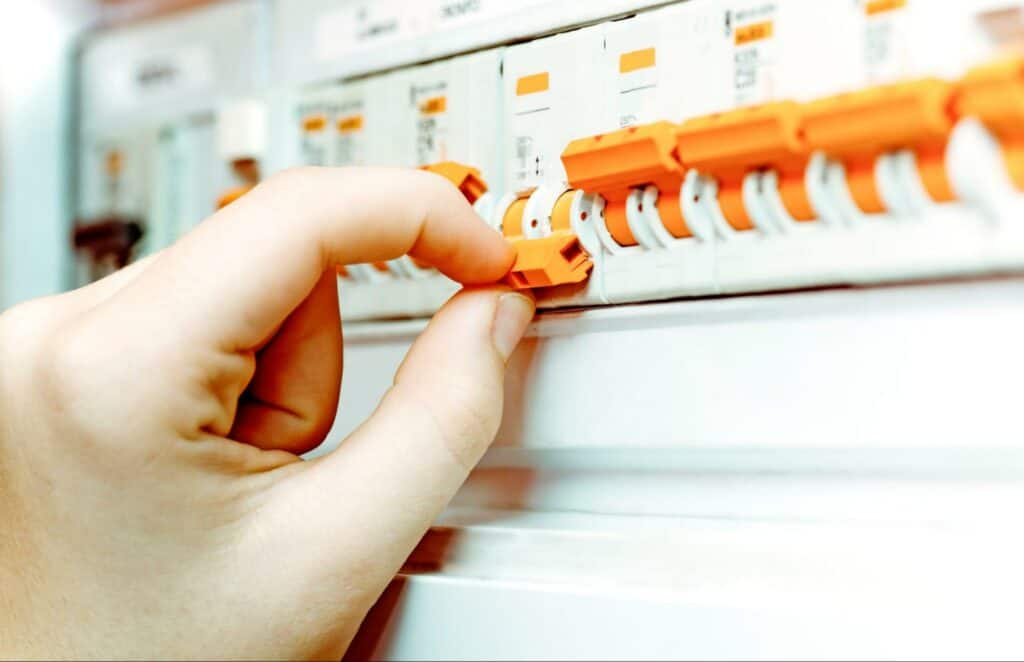Electricity terms often get confused: volts, amps, watts, and ohms.
What do they all mean?
Understanding the difference between them (and how they’re related) can help you better understand how your electrical devices work and make better sense of the specs and requirements for your appliances.
Let’s take a closer look.
What Is an Amp?
An amp (short for ampere) is a unit of measure for electrical current. It measures the rate at which electrons flow through a conductor.
Amps are calculated by measuring the strength of the electromagnetic force between two electrical conductors carrying electric current.

One of the most common places to see amps used in your home circuit panel. Circuit breakers for man appliances are rated at 15 – 20 amps. If the current exceeds the amperage, the breaker will trip to help protect your home. HVAC systems may use breakers rated up to 30 amps.
When using amps mathematically, amps equal the watts divided by the volts of an appliance. So, the formula looks like this:
Amps = Watts/Volts
Let’s say we’re calculating the amps of an appliance, and we know that its wattage is 3000W and voltage is 200V.
Using our formula, we can plug these figures in:
Amps = 3000W/150V = 20 A
What Is a Volt?
A volt measures the electrical potential difference or electromotive force. It measures how much energy each charging unit carries when moving between two points in a system.
Mathematically, you can use this equation to calculate volts if you know the watts and amps of an appliance:
Volts = Watts/Amps.
If we’re calculating the volts of something with a wattage of 500W and amps of 2A, we can use our formula to determine the appropriate voltage of the appliance.
Volts = 480W/2A = 240V
Standard household electricity in South Africa is delivered to homes at 230V, though some large appliances and systems like HVAC and water heaters may require 400V.
On-grid mains’ electricity voltage varies widely by country — something to keep in mind when travelling. Smartphones and laptops can usually handle between 110V and 240V, but many appliances cannot.
What Is a Watt?
A watt is a unit of measure for power, which measures how much electricity an appliance requires to turn on and operate. Wattage is probably the most familiar unit of electricity.
Watt hours (Wh) or kilowatt hours (kWh) measure how much power an appliance consumes over time. You’re probably familiar with kWh from your electricity bill, as that’s how most utilities charge you for the energy you consume.
There are also two measurements of watts for some appliances that require more energy to turn on. These are starting watts and running watts. EcoFlow’s portable power stations offer X-Boost to accommodate higher starting wattages of up to double the running wattage to meet such requirements.
To calculate watts, use this equation:
Watts = Amps x Volts
Let’s say we’re figuring out the watts of a device that uses 4 amps and 220 volts. We plug these figures into our formula:
Watts = 4A x 220V =880W
What Is an Ohm?
Finally, an ohm measures electrical resistance, or how much power it takes to make electrons flow through an object. This is also known as the resistance created by wiring and devices as electricity passes through.
When one volt is applied to two points of a conductor and produces an electrical current of one ampere, the natural resistance this creates is equal to one ohm.
Use this formula to calculate ohms based on volts and amps.
Ohms = Volts / Amps
If you’re finding the ohms of a device that uses 4 volts and 1 amp. We can plug these figures into our formula:
Ohms = 200V/10A = 20 Ω
The Connection Between Amps, Watts, Volts, and Ohms
Still unsure about how amps, watts, volts, and ohms are related? Ohm’s Law Wheel can help.
(Source: Ohmslawcalculator)
Using the appropriate formula from the wheel, you can calculate whatever measurement you need using units you already have.
For example, if a device consumes 4000W when running and requires 240V, you can use this formula to find intensity (represented by I in the wheel, measured in amps).
Amps = W/V is the formula we’ll use.
Using the above example:
Amps = 4000W/240V
Which gives us 16.6A
This indicates that a standard 15-amp circuit breaker wouldn’t be sufficient to operate this appliance. But a 20-amp or circuit would be suitable. Of course, one circuit breaker can provide electricity for multiple plugs. That’s why you throw a circuit breaker or blow a fuse when you plug in too many appliances at once.
Still stuck? Instead of thinking about these as measurements of electricity, think of a river instead.
The voltage of the river would be its orography, also known as the difference in height that propels the water to flow from the mountains to the sea. This grade is essential, as the water would remain stagnant without it, and there would be no river. There’d also be no electrical current without voltage.
Then there’s amperes or intensity, measuring how much water flows down the river. By choosing a rate at which you measure the water coming down, such as hours, you’d calculate amp-hours (or Watt-hours.)
Regarding wattage (or power), that would be the energy carrying the current. The power is impacted by both the orography (height) and water flow (intensity), so the higher these two measurements are, the more potential for power the river would have.
And we’ve finally reached ohms or resistance. This term could refer to the rocks in the river or any bottlenecks in the river geography that resist water flow. The resistance will be lower if there’s a lot of height and intensity.
Frequently Asked Questions
The difference between volts and watts is that voltage measures electric potential, while wattage measures power. Voltage measures the electrical force pushing electrons through a circuit, while watts measure the amount of energy required for an appliance to start and run. Think of it like this: volts push the electricity, while watts measure how much electricity is consumed.
Amps measure electrical current, and watts measure power consumption. Amps indicate the number of electrons flowing through a circuit at any given moment, while watts measure how much energy an appliance requires to turn on and operate. Watt-hours or kilowatt-hours measure electricity consumption over time.
Final Thoughts
Understanding how amps, volts, watts, and ohms are related can help you understand the electricity consumption of an appliance or calculate how much electricity your home needs.
This information can be crucial, especially if you are looking to go off-grid or harness solar energy, which can require you to understand the ins and outs of your electrical appliances.
Want to take control of your home’s electricity needs and achieve energy independence?
Check out EcoFlow’s portable power stations and whole home generator solutions today.
